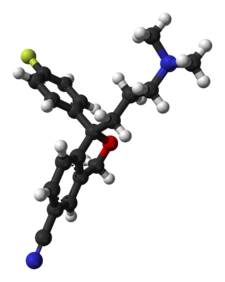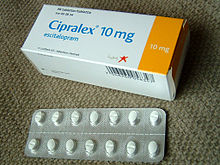Escitalopram
Appearance
 | |
 | |
| Clinical data | |
|---|---|
| Pronunciation | |
| Trade names | Cipralex, Lexapro, others |
| AHFS/Drugs.com | Monograph |
| MedlinePlus | a603005 |
| License data | |
| Pregnancy category |
|
| Routes of administration | By mouth |
| Drug class | Selective serotonin reuptake inhibitor |
| ATC code | |
| Legal status | |
| Legal status | |
| Pharmacokinetic data | |
| Bioavailability | 80% |
| Protein binding | ~56% |
| Metabolism | Liver, specifically the enzymes CYP3A4 and CYP2C19 |
| Elimination half-life | 27–32 hours |
| Identifiers | |
| |
| CAS Number | |
| PubChem CID | |
| DrugBank | |
| ChemSpider | |
| UNII | |
| ChEBI | |
| ChEMBL | |
| ECHA InfoCard | 100.244.188 |
| Chemical and physical data | |
| Formula | C20H21FN2O |
| Molar mass | 324.392 g/mol (414.43 as oxalate) |
| 3D model (JSmol) | |
| |
| |
| | |

Escitalopram is an antidepressant medication. It is used as a drug to help treat depression, obsessive-compulsive disorder, social anxiety disorder and other mental illnesses. It is commonly known and sold as Lexapro or Cipralex.[1]
Side Effects
[change | change source]Escitalopram can cause sleeping problems, dry mouth and diarrhea. It can also cause sexual problems.[2] These sexual problems usually disappear after a person stops using the drug. However, in some cases these problems can last for months or years.
Related pages
[change | change source]References
[change | change source]
